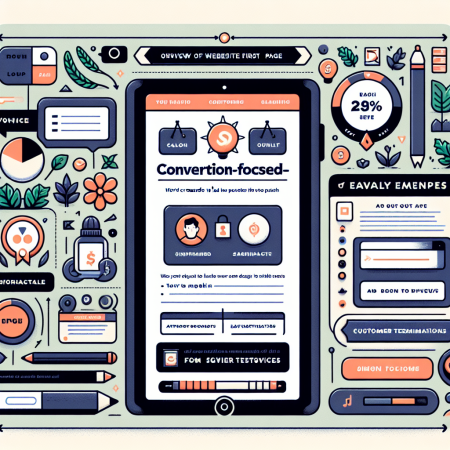How to Create a Conversion-Focused Homepage
Main Section 1
In the first subsection, it’s important to clearly define your unique value proposition. This should be a concise statement that tells visitors what sets your company apart from the competition. Make sure this message is prominently displayed on your homepage to capture visitors’ attention immediately.
Next, include a strong call-to-action (CTA) that directs visitors towards the action you want them to take. Whether it’s signing up for a newsletter, requesting a demo, or making a purchase, your CTA should be clear, compelling, and easily clickable. Consider using contrasting colors to make it stand out.
For the third subsection, showcase social proof such as testimonials, reviews, or case studies to build credibility with your audience. People are more likely to trust a brand that others have endorsed. Include quotes from satisfied customers or clients to demonstrate the value of your products or services.
Lastly, incorporate trust signals like security badges, industry awards, or certifications to reassure visitors that their information is safe with your company. Trust is a key factor in driving conversions, so make sure to highlight any credentials that set your business apart.
Main Section 2
When designing your homepage, focus on creating a visually appealing layout that is easy to navigate. Use high-quality images and graphics that enhance your brand messaging and capture the attention of visitors. Keep the design clean and uncluttered to guide users towards the most important sections of your site.
Ensure that your homepage loads quickly to prevent visitors from getting frustrated and leaving before they even see your content. Optimize images, minimize server requests, and leverage caching to improve site performance. A fast-loading site can significantly impact conversion rates.
In the third subsection, consider implementing interactive elements such as animated graphics, sliders, or interactive forms to engage users and encourage them to explore further. Interactive content can increase time spent on your site and lead to higher conversions by keeping visitors interested and involved.
Finally, make sure your homepage is responsive and mobile-friendly. With the increasing number of users accessing websites on mobile devices, it’s crucial that your site renders correctly on all screen sizes. A seamless mobile experience can drive conversions and improve user satisfaction.
Main Section 3
Personalization is key to creating a conversion-focused homepage. Tailor your messaging to different audience segments based on their preferences, behavior, or demographics. Use dynamic content to show relevant information to each visitor, increasing the chances of conversion.
Utilize data analytics and A/B testing to understand how visitors interact with your homepage and identify any areas for improvement. Test different variations of headlines, CTAs, and layouts to determine what resonates best with your audience and drives the highest conversions.
Incorporate a live chat feature on your homepage to provide immediate assistance to visitors and address any questions or concerns they may have. Real-time support can help alleviate doubts and guide users towards making a purchase or taking the desired action on your site.
Implement exit-intent pop-ups to capture leads from visitors who are about to leave your site. Offer a special discount, content download, or free trial in exchange for their email address. This strategy can help you re-engage potential customers and nurture them towards conversion.
Main Section 4
Optimize your homepage for search engines by incorporating relevant keywords and meta tags. Ensure that your content is SEO-friendly and follows best practices to improve visibility in search results. A well-optimized homepage can attract organic traffic and increase the likelihood of conversions.
Offer valuable content such as blog posts, case studies, or whitepapers on your homepage to educate visitors and showcase your expertise. Content marketing can help position your brand as a thought leader in your industry and attract qualified leads who are more likely to convert.
Integrate social media buttons on your homepage to encourage visitors to share your content with their networks. Leverage social proof and user-generated content to expand your reach and credibility. Social sharing can drive traffic to your site and increase brand awareness, leading to more conversions.
Track key performance indicators (KPIs) such as conversion rate, bounce rate, and average session duration to measure the effectiveness of your homepage. Use these metrics to identify areas that need improvement and optimize your homepage for better results. Continuous monitoring and optimization are essential for a high-converting homepage.
Main Section 5
Utilize heatmaps and user session recordings to analyze how visitors interact with your homepage. Identify areas of high engagement and potential friction points that may be hindering conversions. Heatmaps can provide valuable insights into user behavior and help you make data-driven decisions to optimize your homepage.
Implement multi-step forms or a simplified checkout process to reduce friction and streamline the conversion process. Make it easy for visitors to complete their desired actions without unnecessary obstacles. A frictionless experience can improve conversion rates and customer satisfaction.
Consider implementing exit surveys or feedback forms on your homepage to gather insights from visitors who do not convert. Understand their reasons for leaving and use this feedback to make targeted improvements to your homepage. Continuous feedback helps you iterate and optimize for better conversion results.
Lastly, regularly update and test your homepage to ensure it remains effective in driving conversions. Stay informed about industry trends, user preferences, and technological advancements to stay ahead of the curve. A well-maintained homepage is essential for attracting and converting visitors into customers.
Related Content
- Stay ahead of competitors by merging mindfulness trends with data-driven tactics in 2025
- The Marketing Strategy That Big Brands Don’t Want You to Know
- What Really Happens When You Focus on TikTok Marketing
- The Brutal Truth About Marketing Nobody Wants to Admit
- I Published Content Every Day for 100 Days: Here’s What I Learned

